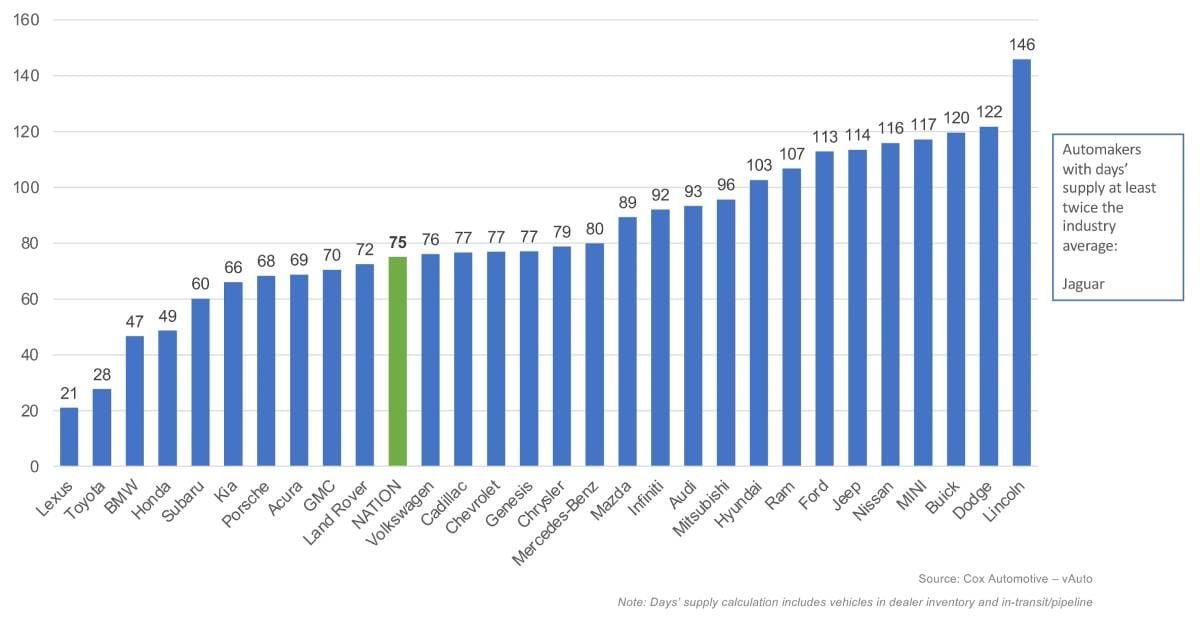The top two luxury brands for 2024, BMW and Lexus, are starting the year off with the lowest days’ supply among luxury brands, at 47 days and 21 days, respectively.
New vehicle sales roared at the end of the year, with a strong December finish, pushing down vehicle inventory.
New vehicle sales rose by 6.5% in December compared to November; inventory fell by 8.5% during the same period. The total U.S. supply of available unsold new vehicles at the start of 2025 stood at 2.88 million units, the first time it registered below 3 million since the end of October, according to an analysis of vAuto Live Market View data, However, this inventory is 18.1% higher than a year ago. The sales pace in December 2024 was also higher year over year by 12.7%.
Among the reasons: Following the resolution of election uncertainties, interest rates began to decline, and inventory levels peaked for the year. This created an ideal blend of improved consumer sentiment, bigger discounts, and evident optimism in the market.
The days’ supply continued to decline in December after increasing in November, dropping by 14.2% month over month to 75 days, mostly unchanged from a year ago.
While the end of the year typically sees an uptick in luxury vehicle sales, December was particularly strong for higher-priced vehicles. The concentration of vehicles priced over $80,000 showed the lowest days’ supply at 62 days. In fact, the top two luxury brands for 2024, BMW and Lexus, are starting the year off with the lowest days’ supply among luxury brands, at 47 days and 21 days, respectively.
Compact SUVs and full-size pickups continue to top the charts for new vehicle sales. The Toyota RAV4, which displaced the Ram 1500 from the top three biggest sellers for 2024, is running at 18 days’ supply with an average listing price of $37,626. The Honda CR-V has 38 days’ supply, more than double that of the RAV4 but still well below the national average of 75 days and priced a little over $200 more. Sales for both models are nearly identical, but Honda has managed to maintain a slightly higher supply.
Notably, Stellantis continues to exercise discipline in production and make good with dealers by extending some of the industry’s highest incentives. Inventory, as promised by leadership, has been coming down. Days’ supply is now lower by up to 52% for the Dodge brand, 40% for Chrysler, and 14% for Jeep year over year. Ram inventory, as measured by days’ supply, is mostly unchanged year over year.
New-Vehicle Pricing Nears $50,000
The latest report showed the average listing price for a new vehicle at $49,853, up 1.8% from a month earlier and 2.4% higher than last year. Meanwhile, Kelley Blue Book reported the average transaction price (ATP) of a new vehicle in the U.S. in December at $49,740, the second-highest ATP in history. Since 2012, the monthly Kelley Blue Book ATP has been $49,000 or above only five times, peaking at $49,926 in December 2022.
In December, new-vehicle sales incentives remained unchanged from November, holding steady at 8% of ATP, or about $3,958. However, compared to peak pricing in December 2022, the average incentive package on a new vehicle last month was higher by 197%, suggesting that inventory is no longer the squeeze driving higher prices. In December 2022, the average incentive was just 2.7% of ATP.
While luxury left its mark on December sales, incentive packages as a percentage of ATP were nearly identical for luxury and non-luxury at 7.9% and 8%, respectively. Nissan, Volkswagen, and Ram provided incentives above 13%, while Toyota, Land Rover, and Porsche kept their incentives below 5% of the average transaction price.

